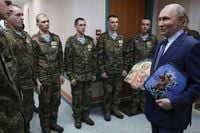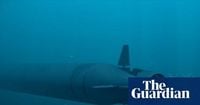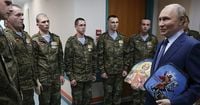Russia has once again thrust its military ambitions onto the world stage, with President Vladimir Putin announcing the successful test of the Poseidon, a nuclear-powered underwater drone that he claims cannot be intercepted. The announcement, made on October 29, 2025, came during a meeting with soldiers wounded in Ukraine—a symbolic backdrop that underscored the ongoing tensions between Moscow and Washington over the conflict in Ukraine.
According to multiple reports, including those from The Associated Press and The Independent, the Poseidon drone is not just another addition to Russia’s arsenal. It is atomic-powered, capable of carrying a nuclear warhead, and, as Putin put it, “unmatched in speed and depth.” The Russian president emphasized, “There is no way to intercept it.” The Poseidon was tested running on nuclear power for the first time on October 28, 2025, after being launched from its carrier submarine. This feat, Putin said, marks a significant leap in underwater military technology.
But what makes Poseidon so formidable? For starters, the nuclear reactor powering the drone is “100 times smaller than those on submarines,” according to Putin. Yet, despite its compact size, the warhead it can carry is “significantly higher than that of our most advanced Sarmat intercontinental ballistic missile.” Russian media have reported that Poseidon can travel at speeds up to 200 kilometers per hour (124 mph)—a velocity that leaves current torpedoes and warships in the dust. Its nuclear propulsion confers virtually unlimited range, making it not only fast and deep-diving but also exceedingly difficult for any adversary to locate or intercept.
Putin first unveiled the Poseidon concept in his 2018 state-of-the-nation address, grouping it alongside other futuristic weapons designed to counter U.S. missile defense systems. Russian military planners have long harbored concerns that such shields could embolden Washington to launch a first strike, hoping to neutralize most of Moscow’s nuclear arsenal and intercept any retaliatory missiles. The Poseidon, in this context, is meant to be a guaranteed means of retaliation—a weapon that could slip past any shield and deliver a devastating blow.
Though Putin was tight-lipped about the exact location of the Poseidon tests, he did offer some insight into the trial’s significance. “For the first time, we managed not only to launch it from its carrier submarine ... but also to activate its nuclear power unit, allowing the vehicle to operate for a certain period of time,” he explained. He added, “In terms of speed and operating depth, there is nothing like this unmanned vehicle anywhere in the world, and it’s unlikely that anything similar will appear in the near future.”
Russian media have speculated that Poseidon is designed to explode near enemy coastlines, potentially triggering a radioactive tsunami. This chilling capability, while not officially confirmed by the Kremlin, has fueled anxiety in Western defense circles about the potential for catastrophic, hard-to-defend-against attacks.
The Poseidon test was not the only nuclear milestone Russia celebrated this month. Just three days before the underwater drone’s trial, Putin lauded another breakthrough: a successful test of the Burevestnik, a nuclear-powered cruise missile. The Burevestnik, which means “storm petrel” in Russian, is touted as the world’s first nuclear-powered missile. Its miniature nuclear engine is “1,000 times smaller than one on a submarine,” Putin said, and can be started in minutes—unlike submarine reactors, which take hours to activate. He described the design as “an engineering breakthrough and a huge achievement.”
On October 21, 2025, General Valery Gerasimov, Russia’s chief military officer, reported to Putin that the Burevestnik had completed a “complete success” test. The missile covered 14,000 kilometers (8,680 miles) during a 15-hour flight using nuclear fuel. Even more impressively, it conducted maneuvers “demonstrating its high capabilities in evading missile and air defense systems,” Gerasimov said. The Burevestnik’s nuclear propulsion gives it virtually unlimited range, allowing it to loiter for days, circle enemy air defenses, and strike from unexpected directions. This flexibility, in the eyes of Russian strategists, is a direct response to what they see as the growing threat posed by U.S. missile shields.
Putin was clear about the broader context of these developments. He cast the Poseidon and Burevestnik as part of Russia’s response to the U.S. missile shield that Washington has expanded since its 2001 withdrawal from a key Cold War-era pact limiting missile defenses. “These weapons guarantee retaliation to a first strike,” Putin has repeatedly stated, reminding the world that Russia is prepared to use “all means” to protect its security interests. This latest show of force comes at a time when U.S.-Russia relations are at a low point, with President Donald Trump recently putting a planned Budapest summit with Putin on hold and imposing new sanctions on Russia following his return to the White House.
The timing of Putin’s announcement—delivered as he met with wounded soldiers in a Moscow hospital—was itself a pointed message. It served to rally domestic support, project strength to adversaries, and signal that Russia’s military innovation is undeterred by Western pressure. The president has made nuclear signaling a key part of his rhetoric since the invasion of Ukraine in February 2022, repeatedly reminding the world of Moscow’s nuclear capabilities.
While the technical details of these new weapons are impressive, the strategic implications are even more profound. The Poseidon and Burevestnik are not just technological marvels; they are political statements. They assert Russia’s determination to maintain strategic parity—or even superiority—despite Western sanctions, diplomatic isolation, and ongoing conflict in Ukraine.
Of course, these developments have not gone unnoticed in Washington and other Western capitals. Defense analysts have warned that the Poseidon, with its combination of speed, depth, and stealth, could render existing anti-submarine and missile defense systems obsolete. The Burevestnik’s unlimited range and evasive maneuvers pose a similarly daunting challenge for air defense planners. Both weapons, if deployed in significant numbers, could shift the balance of power and complicate future arms control efforts.
As the world watches this new chapter in the nuclear arms race unfold, one thing is clear: Russia’s latest tests are not just about military hardware. They are about signaling resolve, deterring adversaries, and shaping the strategic landscape for years to come. With tensions over Ukraine showing no signs of abating, and both sides digging in their heels, the stakes have rarely felt higher.
For now, the Poseidon and Burevestnik remain symbols of a resurgent Russian military—technological achievements that send a clear message: Moscow is determined to remain a force to be reckoned with, both above and below the waves.


